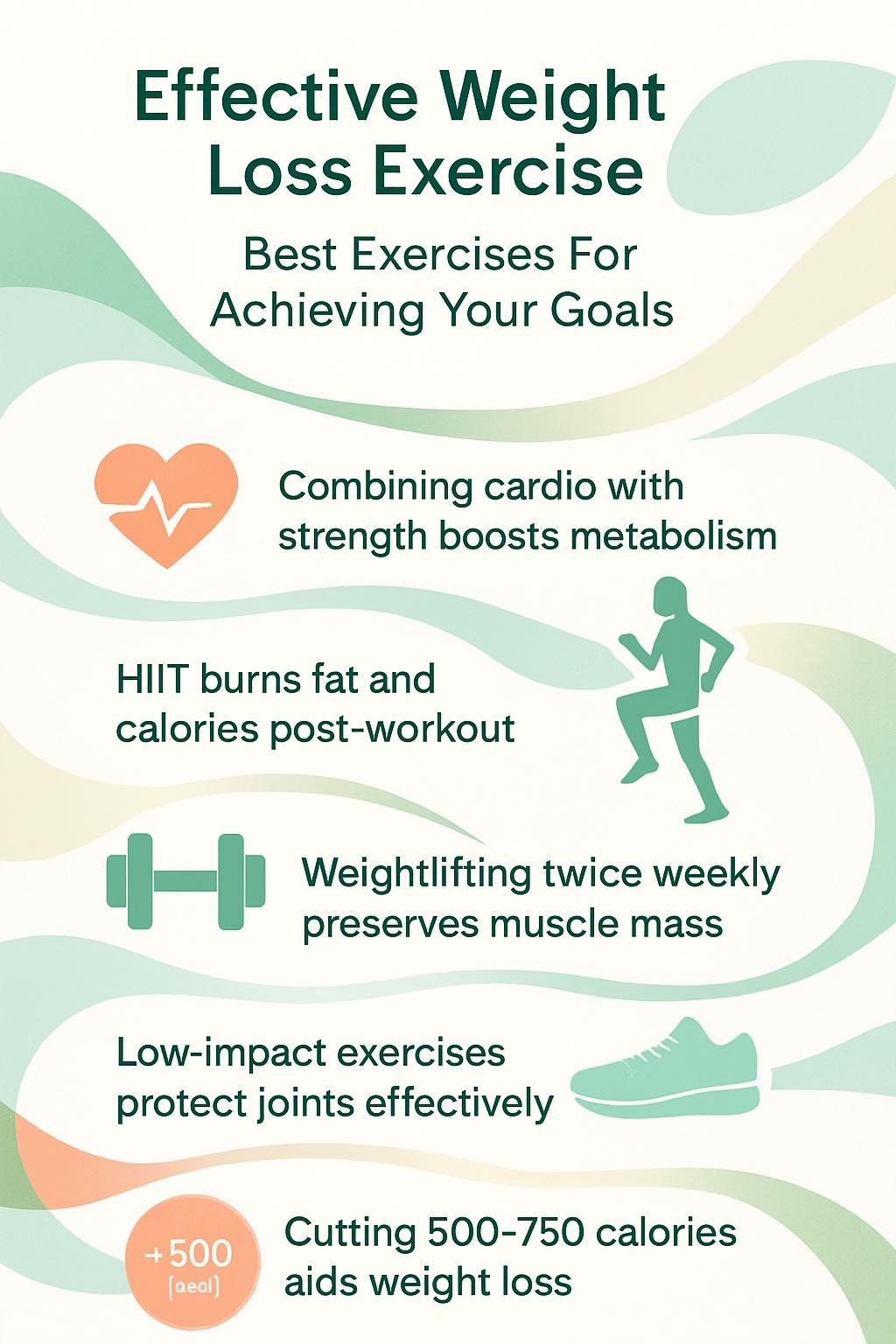Effective Weight Loss Exercise: Best Exercises For Achieving Your Goals
Our Nutrition Assistant AI Suite will transform your body. You will lose fat, get toned, and build muscle. Gain confidence and optimal health.
Trying to lose weight but unsure which workouts matter most? Exercise for weight loss helps you burn more calories than you eat, which supports steady, lasting results.
This guide shares the best exercises for weight loss, why they work, and how to fit them into your day. Simple moves can lead to big wins if you stay consistent.
Key Takeaways
- Pair aerobic exercise, such as running or cycling, with strength training to boost fat loss and raise metabolism. This combo supports effective weight control, as the CDC recommends.
- High-Intensity Interval Training, or HIIT, burns more visceral fat than steady cardio and keeps calorie burn elevated for up to 24 hours after a session, according to a 2023 review.
- Weightlifting or other resistance training at least two days per week preserves lean muscle. More muscle raises your basal metabolic rate, so you burn more calories at rest, supported by a 2022 study.
- Low-impact choices like walking, swimming, yoga, and elliptical workouts protect your joints while still delivering strong calorie burn and long-term weight management, per Mayo Clinic guidance.
- Set realistic goals, track more than the scale, create a balanced diet with a 500 to 750 calorie daily deficit, and schedule rest days to prevent injury and progress plateaus.

Why Exercise is Essential for Weight Loss

Exercise supports weight loss by increasing the number of calories you burn. It also improves heart health, mood, and long-term fitness. When paired with smart eating, it helps you reach and keep a healthy weight.
How does exercise help burn calories?
During physical activity, muscles need energy. That energy comes from calories. Brisk walking for 30 minutes can burn about 150 extra calories. Cardio, which means continuous movement that raises your heart rate, includes running, cycling, swimming, and jumping rope.
Jumping rope usually burns more calories per minute than walking on a treadmill. Biking can burn roughly 400 to 750 calories per hour, depending on speed, body weight, and terrain or bike type.
As you exercise, heart rate and body temperature rise. Your muscles contract more often, which increases energy use. Jogging burns calories during the run and also lifts your metabolic rate, so your body keeps burning extra calories for up to 24 hours afterward.
Adding daily bike rides once helped me lower body fat without big diet changes. Research also suggests regular physical activity may curb appetite in active adults and people with obesity. That can make it easier to stick to a calorie deficit over time.
What effect does exercise have on metabolism and fat loss?
HIIT, a style of short, hard intervals with rests, is powerful for reducing belly fat and deeper visceral fat. A 2023 review found HIIT outperforms moderate continuous cardio for burning this harmful fat. The afterburn effect, called excess post-exercise oxygen consumption, can last up to a day.
Jogging can raise your metabolic rate long after your workout. Strength training builds and protects lean muscle, which uses more energy than fat tissue. More lean muscle increases basal metabolic rate, the calories you burn at rest. A 2021 review reported meaningful weight loss and large reductions in visceral fat from structured exercise programs in adults with excess weight.
Strength training boosts fat burn by increasing muscle mass.
Aerobic exercise improves body composition by lowering total body weight and waist fat. If your aim is to lose one pound of fat, consistent exercise paired with smart nutrition supports healthy, sustainable results.
How does building lean muscle aid weight loss?
Resistance training, such as squats, lunges, and push-ups, builds lean muscle. Muscle tissue burns more calories at rest than fat tissue. That means you use more energy all day, even while sitting or sleeping.
A 2022 study shows combining cardio with strength work preserves more muscle than cardio alone. If you slash calories without lifting, your body may lose muscle along with fat. The CDC advises at least two days per week of muscle-strengthening activities.
When I added three to five short lifting sessions per week, my clothes fit better and my energy improved. Stronger muscles also support bone health, which helps lower the risk of osteoporosis as you age.
Next, explore the best cardio choices to burn calories efficiently.
Best Cardiovascular Exercises for Weight Loss
Cardio raises your heart rate and helps you burn many calories in a short time. These options make it easier to lose weight while building endurance.
Is walking effective for losing weight?
Yes. A 30-minute brisk walk can burn about 150 extra calories. Walking faster or going longer increases the calories you burn, which makes it an easy weight loss option for most people.
The Mayo Clinic suggests at least 300 minutes of moderate activity per week for weight loss. Walking is low impact, so it is gentle on your joints and reduces injury risk. It requires no special equipment and fits into daily life, such as lunch breaks or phone calls.
I started with short neighborhood loops and added pace and distance over time. Walking helped me keep a healthy body mass index and maintain my progress.
Walking is the most accessible form of exercise for nearly everyone, says the American Council on Exercise.
Regular walks support heart health, lower the risk of type 2 diabetes, and can improve cholesterol levels while you lose weight.
How does jogging or running support weight loss?
Jogging builds on walking and burns more calories per minute. Many people average roughly 100 calories per mile, depending on pace and body weight. Interval sprints raise the calorie burn further.
Running strengthens the calves, thighs, and hips. It also supports heart health and lowers the risk of heart disease. Combined with a balanced diet, jogging often speeds fat loss more than gentle activity alone. Three runs per week helped me lose my first 10 pounds faster than walking did.
Why is cycling good for weight loss?
Cycling is a low-impact workout that is easy on your joints. In 60 minutes, many riders burn about 400 to 750 calories, depending on speed, resistance, and body weight. You can ride outside or on a stationary bike.
Health professionals recommend cycling for a wide range of fitness levels. It builds endurance, supports heart health, and helps maintain lost weight. Group rides can add motivation if you enjoy a social boost.
What are the benefits of swimming for weight loss?
Water supports your body, so swimming puts less load on your joints and back. People with joint pain or arthritis often feel more comfortable in the pool than on hard ground.
Different strokes, like front crawl, backstroke, and butterfly, train both upper and lower body. This full-body workout improves muscle tone and core strength. Swimming can also lower blood pressure and LDL cholesterol and reduce the risk of heart disease, stroke, type 2 diabetes, and some cancers.
All ages can benefit, and most communities have access to a pool through a gym or recreation center.
Can jumping rope help me lose weight?
Jumping rope is portable, fast, and effective. It often burns more calories than walking on a treadmill in the same time. For instance, a 155-pound person may burn about 372 calories in 30 minutes of jumping rope, while 30 minutes of treadmill walking may burn about 149 calories.
This exercise engages your core, arms, and legs. It supports fat loss and boosts cardio fitness. You can do it almost anywhere, which helps busy schedules. Many people use it in HIIT sessions for time-efficient results.
High-Intensity Interval Training (HIIT)
Short bursts with built-in rests can deliver big results in little time.
What are the benefits of HIIT for weight loss?
HIIT can burn a high number of calories in 10 to 20 minutes. The afterburn effect can keep your body in a calorie-burning state for up to a day. A 2023 review found that HIIT reduces visceral fat faster than steady moderate cardio.
Studies show strong weight loss in many adults with excess weight who follow HIIT plans, especially when paired with diet changes. Some evidence suggests HIIT may help reduce appetite in certain settings, such as low-calorie diets.
In my routine, bike sprints with short rests led to faster fat loss than steady cycling. The short workouts fit busy days, but plan recovery. Daily all-out sessions are not recommended.
What are some effective HIIT exercises like burpees, mountain climbers, and sprints?
HIIT features quick, intense moves that keep your heart rate high. Rotate a few of the options below to train your whole body and keep workouts interesting.
- Burpees work your arms, chest, legs, and core at once. Short intervals torch calories and build cardio fitness.
- Mountain climbers challenge your shoulders and core while driving heart rate up within seconds.
- Sprints, outdoors or on a stationary bike or elliptical trainer, push intensity. Try 30 seconds hard, then rest.
- Jumping rope delivers rapid calorie burn. Alternate fast sets with easy hops.
- High knees, done in place, keep intensity up and reinforce strong running form.
Keep form sharp as speed rises. If joints feel irritated, switch to lower impact options while keeping intervals tough.
- Plyometric push-ups add a small jump to the push-up to build power and increase calorie burn.
- Cycling sprints let you dial in resistance. This low-impact choice helps protect knees while staying intense.
- Swimming intervals alternate fast laps with easy strokes for a joint-friendly HIIT session.
- Box jumps build leg power. Use a sturdy platform, jump up, step down, and repeat within timed rounds.
- Shadowboxing in short bursts boosts cardio and coordination without equipment.
- Mixing several of these moves creates variety for beginners and advanced athletes while keeping progress steady.
Strength Training for Effective Weight Loss
Strength work helps you burn more calories around the clock and shapes lean muscle that supports joint health and posture.
How does weightlifting and resistance training aid weight loss?
Resistance training builds lean muscle mass. Each new pound of muscle uses extra energy every day, even during rest. That makes fat loss easier over time.
The CDC recommends at least two muscle-strengthening days per week, such as squats, rows, or push-ups. A 2022 study shows that combining resistance training with cardio preserves more muscle than cardio alone. Aim for three to five sessions weekly, about an hour each, and add rest days to recover and avoid injury.
Stronger muscles also support bones and joints, which helps you stay active and maintain weight loss.
How do squats, lunges, and push-ups contribute to weight loss?
These compound moves train multiple muscle groups at once and increase calorie burn during and after workouts. Squats and lunges target the glutes, quads, hamstrings, and calves while engaging your core. Push-ups build the chest, shoulders, arms, and core.
As lean muscle increases, resting calorie burn rises. For example, adding even a few pounds of muscle can meaningfully raise daily energy use. Doing a short set of squats or lunges before a long walk helped my legs feel stronger and sped up progress.
These movements also improve daily function, such as lifting groceries or climbing stairs with ease.
Why is building muscle important for burning more calories?
Muscle tissue is active tissue. It needs more energy to maintain itself than fat tissue does. Adding muscle through consistent strength training raises the calories you burn all day, which supports long-term weight control.
When reducing calories, lifting helps protect that muscle and reduces the chance of a slow metabolism. The scale may not drop quickly if you add muscle while losing fat. Body measurements and how your clothes fit often show progress sooner.
Strength training also supports bone density, which lowers fracture risk as you age.
Low-Impact Exercises for Beginners
Gentle does not mean easy. Low-impact options protect joints while helping you burn calories and manage stress.
Can yoga help with weight loss?
Yes. Practicing yoga once a week for at least 30 minutes can support lower BMI and healthier body composition. Yoga blends movement with breathing and attention, which can reduce stress-driven eating and improve food choices.
Poses can be modified for any level. Sessions burn calories, build strength, and improve flexibility and balance. After I made yoga a weekly habit, cravings were easier to manage and I felt calmer during busy days.
Consistent practice is linked with better long-term weight management.
How does Pilates support weight loss goals?
Pilates builds lean muscle and strengthens the core while staying gentle on joints. As muscle increases, your body burns more calories at rest. Pilates also improves posture, balance, and flexibility.
Research on the effect of Pilates exercise on body composition shows gains in muscle and reductions in fat. You can scale intensity in studio or online classes. Pairing Pilates with walking, cycling, or light lifting creates a comprehensive plan that supports fat loss.
Summary: Pilates builds lean muscle, supports posture, improves balance, increases session calorie burn over time, strengthens stabilizers for better movement, and fits beginners or experienced exercisers.
Is elliptical training a good low-impact workout for weight loss?
Elliptical training provides a joint-friendly cardio workout with adjustable resistance and incline. A 30-minute session often burns roughly 270 to 400 calories, depending on effort and body weight.
This makes it a useful choice for people who need a lower impact plan, including those coming back from injury. Consistent use improves cardiovascular fitness and supports fat loss. After knee surgery, I switched to the elliptical and lost 15 pounds without the joint flare-ups I had during high-impact workouts.
Next up, outdoor activities that make calorie burn feel like an adventure.
Outdoor Activities to Support Weight Loss
Fresh air and changing scenery can make exercise more enjoyable and easier to sustain.
How does hiking help with weight loss?
Hiking burns more calories than flat walking because uneven trails recruit stabilizing muscles. A 155-pound person may burn around 430 calories per hour on moderate, uneven terrain, per the American Hiking Society.
Trails vary in length and difficulty, so you can match the challenge to your fitness level. Hiking builds cardio fitness and muscular endurance. Go solo for quiet time or with friends for added motivation.
Can stair climbing be an effective weight loss exercise?
Yes. Stair climbing raises your heart rate quickly and helps you burn calories fast. Climbing just two flights per day can lead to about six pounds of weight loss across a year, based on observational data.
It is easy to access at home, work, or public spaces and requires no equipment. You can scale intensity by adding flights or speeding up. A 10-minute stair session after lunch lifted my energy and moved the scale within weeks.
How does dancing contribute to weight loss?
Dancing combines cardio with coordination. In 30 minutes of fast dancing, a 155-pound person can burn roughly 205 to 400 calories, depending on style and intensity.
Classes like Zumba, hip-hop, or salsa raise heart rate and improve endurance. The social element helps many people stay consistent. Dancing also builds balance and muscle tone, which supports long-term weight control.
Tips for Maximizing Weight Loss with Exercise
Smart planning helps you get more from every workout and keeps the process enjoyable.
How should I combine exercise with a balanced diet for weight loss?
Target a daily calorie deficit of 500 to 750 calories. Many people can expect to lose about 1 to 1.5 pounds per week with that range. Build meals around protein, whole grains, fruits, and vegetables, and track intake to guide choices.
Combine cardio with strength training. Cardio uses calories quickly. Strength work adds lean muscle, which raises resting calorie burn and helps prevent regain. Short HIIT or lower intensity sessions can help some people manage appetite.
Speak with your healthcare provider before major changes, especially if you have medical conditions or take medications.
What are the best ways to stay consistent with workouts?
Set realistic goals, such as three or four sessions per week for 30 minutes. Schedule workouts on your calendar and treat them like appointments. Alternate cardio and resistance days to keep interest high.
Change your routine every few weeks to prevent plateaus. Track progress with body measurements and how clothes fit, not just the scale. Group classes or a workout partner can help with accountability. Sharing weekly updates with a friend helped me stay on track, even during busy times.
How do I monitor progress and adjust workout intensity?
Log exercises, sets, reps, and weights. Measure waist, hips, and other key points every few weeks. These numbers show fat loss better than the scale alone.
Track intensity with heart rate or perceived exertion. Work in the 60 to 80 percent max heart rate zone for effective weight loss exercise. Increase intensity slowly as fitness improves, and refresh your plan every few weeks. Rest days reduce injury risk and support motivation over time.
Ask a certified trainer or healthcare professional for personalized guidance if you want faster, safer progress.
Common Mistakes to Avoid
Steer clear of these pitfalls to protect your body and keep progress going.
What are the risks of overtraining and how to prevent injury?
Overtraining raises injury risk and often leads to fatigue, irritability, and stalled progress. Adding a rest day after every two strength sessions helps muscles recover. Increase intensity gradually to allow your body to adapt.
Focus on good form during squats, lunges, and HIIT moves. Adjust or stop if pain lingers for days. A coach or physical therapist can help tailor a safe routine for your goals and fitness level.
Why should strength training not be ignored?
Skipping strength work can cause muscle loss during dieting. That can slow metabolism and make weight regain more likely. Resistance exercises maintain or build lean muscle, which raises daily calorie burn at rest.
Studies support doing strength work at least twice a week, as the CDC advises. When I relied only on cardio, the scale moved but my muscle tone and energy fell. Adding squats, push-ups, and simple resistance moves improved results and made everyday tasks easier.
How important are proper warm-up and cool-down routines?
Warm-ups prepare your muscles and joints, raising body temperature and range of motion. This reduces the risk of strains and sprains. Skipping warm-ups can increase soreness and slow recovery.
Cool-downs gradually lower heart rate and can reduce dizziness. Light stretching can ease tightness and support faster recovery. Even elite athletes keep these steps in every session because they help prevent injuries and improve performance.
How to Create a Personalized Exercise Plan
A personal plan keeps you focused and makes progress easier to track.
How do I set realistic weight loss exercise goals?
Match your goals to your current fitness and schedule. If you are new, aim for 150 minutes of moderate activity per week, as the CDC recommends. That could be five 30-minute sessions.
Set clear targets you can measure, like total weekly minutes or sessions. Include short-term goals, such as walking three times this week, and longer-term goals, like a 5K in three months. Adjust as you get stronger and celebrate milestones along the way.
How do I choose exercises based on my fitness level?
Start with low-impact options, such as walking, yoga, or the elliptical, if you are a beginner. Build duration first, then increase intensity. For example, begin with 15 minutes, then add time or light resistance across several weeks.
Pick activities you enjoy and modify movements to protect your joints. If you have joint pain, swimming is a helpful alternative. A trainer or clinician can help tailor choices if you have health concerns.
Include both cardio and resistance work. This balanced approach supports fat loss now and better fitness later.
Why is incorporating variety important to stay motivated?
Variety keeps workouts interesting and your body challenged. Switching between cycling, swimming, walking, or dance classes engages new muscle groups and reduces overuse injuries.
Mix indoor and outdoor options to manage weather and prevent boredom. Exercising with friends can raise enjoyment and consistency. Changing from treadmill runs to a weekly dance class once refreshed my routine and boosted motivation.
Summary:
- Changing exercises challenges different muscles and skills.
- Rotating activities prevents plateaus and overuse injuries.
- Social workouts increase enjoyment and accountability.
- Mixing formats builds well-rounded fitness for long-term success.
Conclusion
You can reach your goals with a clear plan and consistent effort. Choose best exercises you will stick with, such as walking, cycling, swimming, strength training, or HIIT. Each one helps you burn calories, build muscle, and improve metabolism.
Pair regular exercise with a balanced diet for steady weight loss. Stay consistent, adjust as you improve, and ask a healthcare professional for guidance when needed. Small steps, done often, lead to a healthier weight and a stronger you.
FAQs
1. What are the most effective exercises for weight loss?
Aerobic activities such as brisk walking, cycling, and swimming help burn calories efficiently. Resistance training with weights or bodyweight movements increases muscle mass, which boosts metabolism. High-intensity interval training (HIIT) combines short bursts of intense activity with rest periods; research shows it can improve fat loss more than steady-state cardio.
2. How often should I exercise to achieve weight loss goals?
The Centers for Disease Control and Prevention recommend at least 150 minutes per week of moderate-intensity aerobic activity or 75 minutes of vigorous-intensity exercise, along with two days per week focused on strength-building activities. Consistency is key to seeing results.
3. Does resistance training help burn fat compared to cardio workouts?
Resistance training builds lean muscle tissue that raises resting metabolic rate, leading to greater calorie use even when not exercising. Studies indicate combining resistance work with aerobic sessions leads to better long-term fat reduction than either method alone.
4. Can personal experience support these recommendations?
After following a structured plan that included both HIIT and strength routines three times a week over several months, many individuals report improved energy levels and noticeable changes in body composition supported by data from fitness trackers and regular measurements.
Summary: Aerobic movement, resistance routines, and high-intensity intervals all contribute to effective weight management when performed regularly. Combining these methods supports lasting success in reaching personal health targets according to current scientific evidence.







